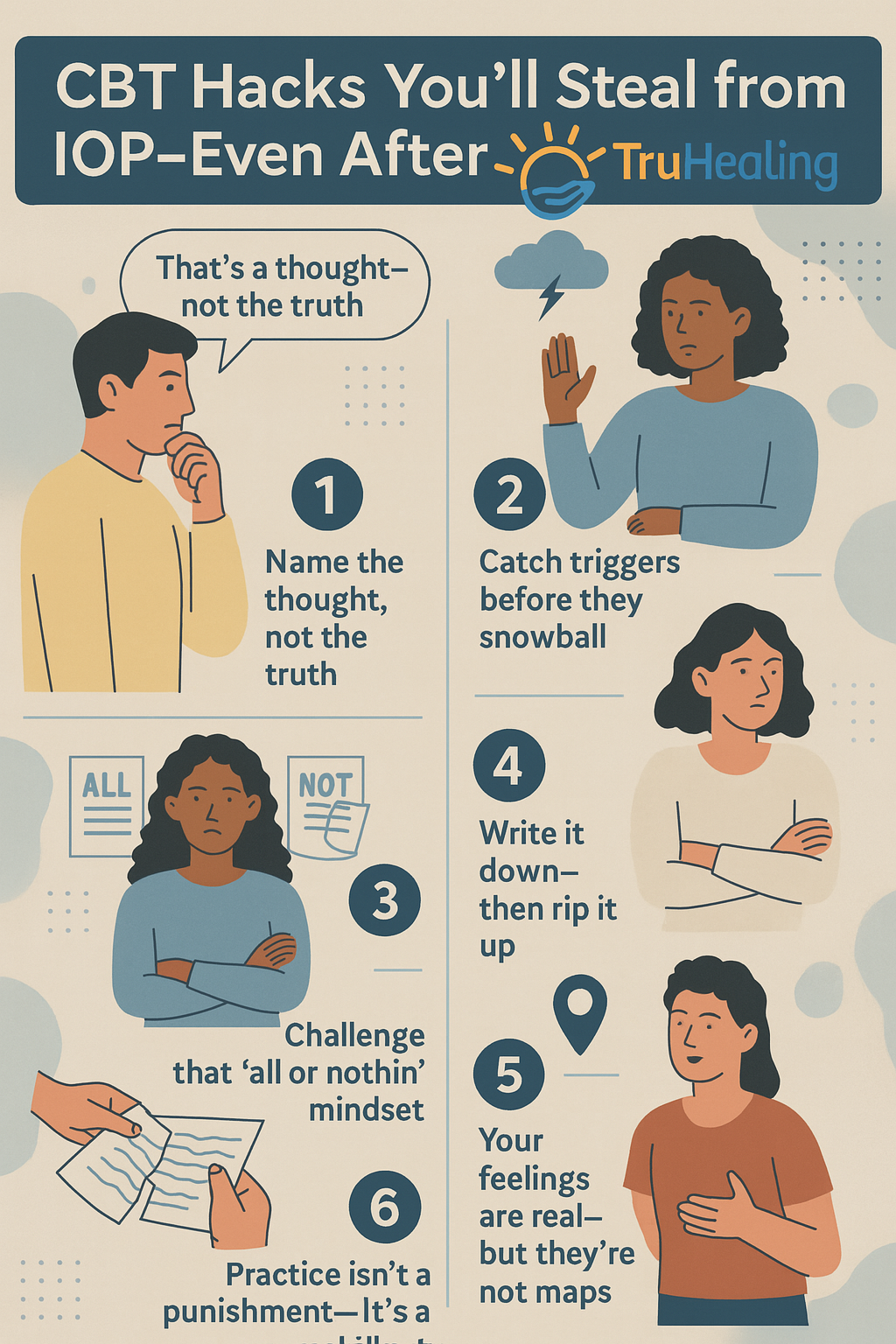Sometimes the hardest part of treatment isn’t starting—it’s starting again after you’ve stopped. Maybe you ghosted your IOP group a few weeks in. Maybe you stuck around, but dropped off the radar quietly. Now there’s guilt. Awkwardness. And a quiet question you haven’t said out loud: Can I still come back?
The short answer: yes.
But even if you’re not ready to return, the truth is this—some of the best parts of IOP are already with you. Below are real, practical Cognitive Behavioral Therapy strategies you’ve likely learned (or heard about) in an intensive outpatient program. They still work—even after you walk away. And they’re worth keeping.
1. Name the Thought, Not the Truth
CBT starts with awareness. That means catching a thought before it becomes your reality.
Say you missed a group session and immediately think: “They probably think I’m a failure.”
Instead of spiraling, CBT invites you to pause and reframe:
“That’s a thought—not a fact.”
It sounds simple, but it’s powerful. Naming a thought as a mental event—not the truth—gives you distance. You don’t have to debate it. You just notice it. And often, that’s enough to loosen its grip.
This strategy is especially helpful if shame has you stuck. You might think you “ruined your shot” by leaving early or using again. But that’s not the truth. That’s a thought. And you get to decide what happens next.
2. Catch Triggers Before They Snowball
Most people don’t just “relapse out of nowhere.” There’s usually a slow build—internal or external—that leads up to it.
IOP helps you map your triggers:
- What led to the craving?
- What came before the anxiety spike?
- What emotion set off the urge to isolate?
Cognitive Behavioral Therapy gives you the tools to identify those patterns early. For example, you may notice you’re more vulnerable when you’re sleep-deprived, overcommitted, or avoiding certain conversations.
The trick is catching the chain before it builds. A single skipped meal or awkward conversation might not seem like a big deal—but it adds up. And once you start seeing the pattern, you can break it.
3. Challenge That “All or Nothing” Mindset
This is a big one for folks who’ve ghosted treatment. The inner script often goes something like:
“I already messed up. I might as well stop trying.”
But CBT calls this what it is: black-and-white thinking. One of its core skills is learning how to create gray space—room between perfection and failure.
You don’t have to “start over.” You don’t need a clean slate. You just need to take the next right step. Even if that’s texting your IOP group, journaling for five minutes, or calling the front desk to ask if you can rejoin.
Progress isn’t erased by pauses. It just waits for you to pick it back up.
4. Write It Down—Then Rip It Up
CBT doesn’t require you to journal every day. But it does ask you to get curious about your thoughts.
Thought records—one of the simplest CBT tools—walk you through:
- What happened?
- What did I feel?
- What was the automatic thought?
- What’s a more balanced thought?
This isn’t about “thinking happy thoughts.” It’s about seeing what your mind is doing, then deciding what to believe.
Some people keep these records in notebooks. Others write them on napkins and toss them. There’s no right way—just your way. The important part is getting it out of your head so you can look at it with fresh eyes.

5. Your Feelings Are Real—But They’re Not Maps
One of the sneakiest traps we fall into is assuming our feelings mean something permanent.
If you feel hopeless, it must mean recovery isn’t possible.
If you feel ashamed, it must mean you’re not worthy of help.
CBT doesn’t dismiss your emotions—but it does challenge their authority. You can feel guilt without deciding you’re broken. You can feel unmotivated and still go to group.
Feelings are weather. They pass. CBT teaches you how to walk through the storm without letting it define the direction of your life.
6. Practice Isn’t a Punishment—It’s a Skillset
The word “homework” can be a turnoff for a lot of people in treatment. But in CBT, practice isn’t a punishment. It’s a way of re-training your brain—one small action at a time.
You don’t have to master every tool. You just have to pick one and try it.
Try labeling a thought next time you feel shame.
Try tracking your energy level over a week to spot patterns.
Try a five-minute breathing exercise when you feel tension rise.
Every time you use a CBT skill, you reinforce a different pathway in your brain. That’s not failure—it’s flexibility. That’s the real work of recovery, whether you’re in group or not.
Even if you’ve stepped away, you’re welcome to return. Our intensive outpatient program in Cincinnati is designed to support real people with real lives—including starts, stops, and everything in between. If you’re local to Lexington, Kentucky or Springfield, Ohio, TruHealing offers help that meets you exactly where you are. You don’t have to explain why you left. You just have to show up.
FAQ: CBT and IOP After You Leave
What if I didn’t finish the program? Can I still come back?
Yes. Treatment isn’t a one-shot deal. At TruHealing Cincinnati, we understand life happens—and recovery isn’t linear. You’re welcome to return and pick up where you left off or start fresh if that feels better.
I only attended a few IOP sessions. Is it worth trying again?
Absolutely. Even a few sessions can introduce powerful CBT tools. Returning gives you a chance to reinforce and apply those tools with new insight and support.
How do I know if CBT is working for me?
Look for small shifts: Are you catching unhelpful thoughts more often? Feeling more aware of your triggers? Making even slightly different choices? Progress in CBT is usually subtle but powerful.
Is CBT only for people with anxiety or depression?
Not at all. CBT is widely used in addiction treatment, trauma recovery, and emotional regulation work. It’s a flexible, practical approach for anyone working on change.
Do I have to “believe” in CBT for it to work?
Nope. You don’t have to love it or even fully buy in. The only requirement is willingness to try the skills and see how they work for you.
📞 Still thinking about coming back? That’s okay. We’re still here.
Call (888) 643-9118 or visit to learn more about our intensive outpatient program services in Cincinnati, Ohio.


